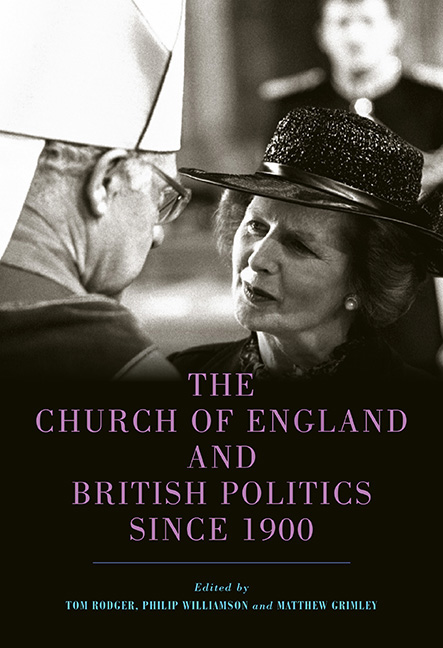Book contents
- Frontmatter
- Contents
- Notes on contributors
- Preface
- Abbreviations and locations of principal collections
- Introduction: the Church of England, the British state and British politics during the twentieth century
- 1 The politics of Church defence: Archbishop Davidson, the national church and the ‘national interest’, c. 1900–14
- 2 Archbishops and the monarchy: leadership in British religion, 1900–2012
- 3 Ecclesiastical conservatism: Hensley Henson and Lord Hugh Cecil on Church, state and nation, c. 1900–40
- 4 Hensley Henson, the prayer book controversy and the conservative case for disestablishment
- 5 Assembling an Anglican view of self-governing sexual citizenship, 1918–45
- 6 Politics in the parish: Joseph Needham at Thaxted, c. 1925–85
- 7 Anglicans, reconstruction and democracy: the Cripps circle, 1939–52
- 8 Parliament and the law of the Church of England, 1943–74
- 9 The Church of England and religious education during the twentieth century 199
- 10 Spiritual authority in a ‘secular age’: the Lords Spiritual, c. 1950–80
- 11 ‘A sort of official duty to reconcile’: Archbishop Fisher, the Church of England and the politics of British decolonization in East and Central Africa
- 12 A ‘baffling task’: Archbishop Fisher and the Suez Crisis
- 13 John Collins, Martin Luther King, Jr, and transnational networks of protest and resistance in the Church of England during the 1960s
- 14 The Church of England, minority religions and the making of communal pluralism
- Index
- STUDIES IN MODERN BRITISH RELIGIOUS HISTORY
2 - Archbishops and the monarchy: leadership in British religion, 1900–2012
Published online by Cambridge University Press: 28 April 2020
- Frontmatter
- Contents
- Notes on contributors
- Preface
- Abbreviations and locations of principal collections
- Introduction: the Church of England, the British state and British politics during the twentieth century
- 1 The politics of Church defence: Archbishop Davidson, the national church and the ‘national interest’, c. 1900–14
- 2 Archbishops and the monarchy: leadership in British religion, 1900–2012
- 3 Ecclesiastical conservatism: Hensley Henson and Lord Hugh Cecil on Church, state and nation, c. 1900–40
- 4 Hensley Henson, the prayer book controversy and the conservative case for disestablishment
- 5 Assembling an Anglican view of self-governing sexual citizenship, 1918–45
- 6 Politics in the parish: Joseph Needham at Thaxted, c. 1925–85
- 7 Anglicans, reconstruction and democracy: the Cripps circle, 1939–52
- 8 Parliament and the law of the Church of England, 1943–74
- 9 The Church of England and religious education during the twentieth century 199
- 10 Spiritual authority in a ‘secular age’: the Lords Spiritual, c. 1950–80
- 11 ‘A sort of official duty to reconcile’: Archbishop Fisher, the Church of England and the politics of British decolonization in East and Central Africa
- 12 A ‘baffling task’: Archbishop Fisher and the Suez Crisis
- 13 John Collins, Martin Luther King, Jr, and transnational networks of protest and resistance in the Church of England during the 1960s
- 14 The Church of England, minority religions and the making of communal pluralism
- Index
- STUDIES IN MODERN BRITISH RELIGIOUS HISTORY
Summary
The Church of England remains the established church in England; it retains representation in the parliament of the United Kingdom; and it continues to be prominent in British public life and influential in British politics. Yet early in the twentieth century, it could appear to be politically vulnerable. It was easily presented as a sectional interest, intent on defending its privileges in England and Wales with the support of the Conservative and Unionist Party. It was assailed by ‘political nonconformity’, expressed through the Liberal Party and from 1905 through a Liberal government, which after the general elections of 1910 was maintained in office by Roman Catholic Irish Nationalist MPs, another group unsympathetic towards the Church's interests. In 1914 this Liberal political alliance partially dismembered the Church of England by an act to disestablish and disendow its dioceses in Wales. Yet, as Matthew Grimley has written, after 1918 ‘the Church of England was in some ways in a stronger national position than it had been in the late Victorian period’. Even as church attendance and traditional Christian belief declined steeply from the 1950s, the Church retained a substantial public presence: in Simon Green's words, the Church ‘survived its unpopularity. Indeed, it might almost be said to have transcended it.’ How did the Church maintain its position and influence through the social, political and religious transformations of the twentieth century?
Explanations of the Church's continued status and influence have turned chiefly on the falling away of denominational and political opposition. Green and Grimley stress the collapse of nonconformity as a coherent political force, and the Liberals as a major political party. Green adds the removal of most Roman Catholic MPs when much of Ireland seceded from the United Kingdom in 1922, and the rise of a Labour Party with no particular denominational attachments or antagonisms. Expressed in more synoptic terms, the political agenda had been transformed. The constitutional and denominational issues that had defined nineteenth-century party politics were almost exhausted, and were replaced during the First World War by the dominance of social and economic issues and by a reconstituted party system. No political party now had particular cause to attack (or defend) the Church of England, and the receding interest in institutional reform removed other pressures on the Church establishment, including episcopal representation in the House of Lords.
- Type
- Chapter
- Information
- The Church of England and British Politics since 1900 , pp. 57 - 79Publisher: Boydell & BrewerPrint publication year: 2020



